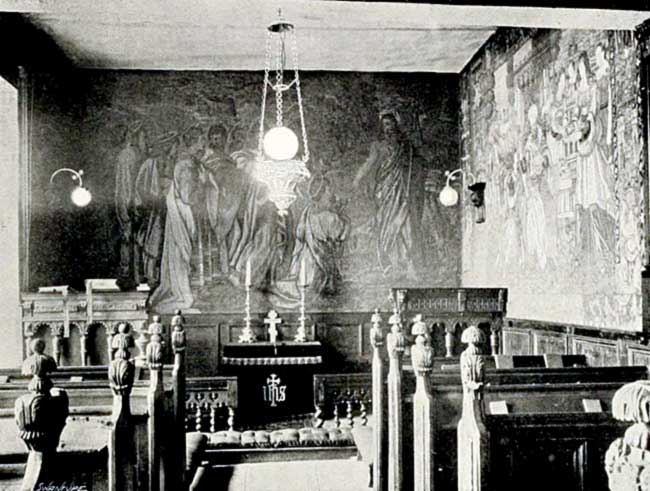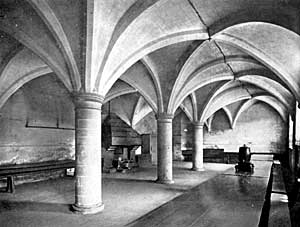
The Chapel.
After the death of Dorothy, Lady Halifax, in 1670, Lord Halifax endeavoured to find distraction in public life, and for a short time represented Great Britain as Minister at the Hague.
In 1674 his second marriage took place, to Gertrude Pierrepont, daughter of William Pierrepont of Thoresby, and granddaughter of the first Earl of Kingston. Lord Halifax died in 1695 and was buried in Westminster Abbey. Macaulay says of him: "Among the statesmen of that age Halifax was, in genius, the first. His intellect was fertile, subtle, and capacious. His polished, luminous and animated eloquence, set off by the silver tones of his voice, was the delight of the House of Lords. His conversation overflowed with thought, fancy, and wit. . .

The Servants' Hall.
He was the chief of those politicians whom the two crreat parties contemptuously called Trimmers. Instead of quarrelling with this nickname, he assumed it as a title of honour, and vindicated, with great vivacity, the dignity of the appellation. 'Everything good,' he said, ' trims between extremes. The temperate zone trims between the climate in which men are roasted and the climate in which they are frozen. The English Church trims between the Anabaptist madness and the Papist lethargy. The English constitution trims between Turkish despotism and Polish anarchy. Virtue is nothing but a just temper between propensities any one of which, if indulged to excess, becomes vice. Nay, the perfection of the Supreme Being Himself consists in the exact equilibrium of attributes, none of which could preponderate without disturbing the whole moral and physical order of the world.' Thus Halifax was a Trimmer on principle. He was also a Trimmer by the constitution both of his head and of his heart. His understanding was keen, sceptical, inexhaustibly fertile in distinctions and objections; his taste refined; his sense of the ludicrous exquisite ; his temper placid and forgiving, but fastidious, and by no means prone either to malevolence or to enthusiastic admiration. Such a man could not long be constant to any band of political allies. He must not, however, be confounded with the vulgar crowd of renegades. For though, like them, he passed from side to side, his transition was always in the direction opposite to theirs. . . . To his lasting honour it must be mentioned that he attempted to save those victims whose fate has left the deepest stain both on the Whig and on the Tory name."
Lord Halifax was succeeded by his son Lord Eland, who married a daughter of the Earl of Nottingham, but leaving no son the Marquisale became extinct, and his cousin Sir John Savile succeeded to the estates and the baronetcy.
The eighth and last baronet was the celebrated Sir George Savile, who in five successive parliaments represented the county of York. He died unmarried in 1784. His sister Barbara Savile married, in the chapel at Rufford, Richard, fourth Earl of Scarborough, and to their younger son John Lumley-Savile Sir George bequeathed his Rufford and Yorkshire estates. Mr. Lumley-Savile ultimately succeeded to the earldom of Scarborough, and was the great-grandfather of the present owner.
George IV., when Prince of Wales, paid a visit to Rufford. During this visit Charles Dibdin the poet, who had accompanied his royal highness as Master of the Ceremonies, wrote his celebrated song "Woodman, spare that tree," after having witnessed the felling of an oak in the park.
